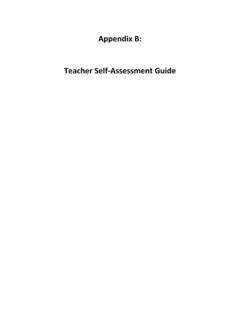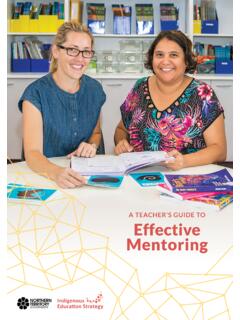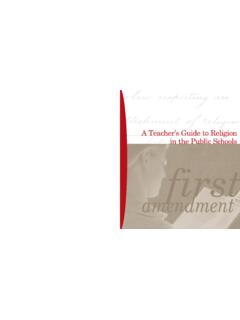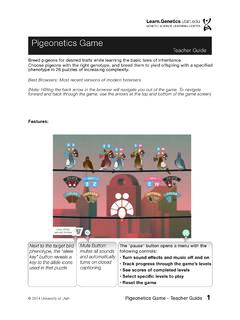Transcription of A Practical Guide to Evaluating Teacher Effectiveness
1 A Practical Guide to Evaluating Teacher EffectivenessApril 2009 Olivia Little, ETSL aura Goe, , ETSC ourtney Bell, , Sec:113/27/09 4:01:59 PM3/27/09 4:01:59 Sec: Sec:123/23/09 8:19:06 PM3/23/09 8:19:06 PMContentsIntroduction .. 1 Defining Teacher Effectiveness .. 1 Methods of Evaluating Teacher Effectiveness .. 4 Valued-Added Models .. 4 Classroom Observation .. 6 Principal Evaluation .. 8 Analysis of Classroom Artifacts .. 9 Portfolios .. 10 Self-Report of Practice ..11 Student Evaluation .. 13 Creating a Comprehensive Teacher Evaluation System .. 15 Recommendations .. 17 References .. 18 Appendix A. Validity and Measurement Terms .. 23 Appendix B. Planning Guide .. 25 Appendix C. Summary of Measures .. 26 Appendix D. Sample of Existing Evaluation Systems .. Sec: Sec:133/23/09 8:19:06 PM3/23/09 8:19:06 PMThis Guide is based on Approaches to Evaluating Teacher Effectiveness : A Research Synthesis (Goe, Bell, & Little, 2008).
2 Articles for the research synthesis were identified through extensive Internet and library searches of keywords and phrases related to the topics of Teacher Effectiveness and measuring Teacher performance from the last six to eight years. Additional articles, including older, seminal, nonempirical, and/or theoretical pieces were identified from broader Internet searches, reference lists of related articles, and recommendations of experts in the field. Data Collection and MethodsThe studies that were evaluated met the following criteria: (1) they were empirical, peer-reviewed journal articles; (2) they were published in English in the United States, Canada, Great Britain, Ireland, Australia, or New Zealand; (3) they addressed the K 12 student population and measured inservice teachers; (4) they included a measure of Teacher Effectiveness or classroom practice and included a student outcome measure or had implications for Teacher Effectiveness ; and (5) they reported methods meeting accepted standards for quality research ( , reliable and validated instruments, appropriate study design, and necessary controls).
3 The resulting synthesis includes approximately 120 studies that were thoroughly reviewed. The research synthesis focused primarily on studies measuring classroom processes and student outcomes, paying particular attention to studies that used value-added measures of Teacher Effectiveness . The authors did not examine more indirect measures of teaching ( , Teacher demonstrations of knowledge, Teacher responses to theoretical teaching situations or structured vignettes, or parent satisfaction surveys). Instead, the synthesis focused on measures that more directly assess the processes and activities occurring during instruction and products that are created inside the classroom. The research synthesis excluded research on school effects, the Effectiveness of curriculum or professional development implementations (unless research included measures specific to teachers), and other evaluations of educational interventions or programming.
4 In addition, the research synthesis did not consider the research linking credentials, experience, or knowledge to Teacher Effectiveness , as this topic has been extensively reviewed (Goe, 2007). Though these are all important and related topics, they were beyond the scope of the research synthesis by Goe et al. (2008).Approaches to Evaluating Teacher Effectiveness : A Foundation for This Sec:143/23/09 8:19:06 PM3/23/09 8:19:06 PM1 There is increased consensus that highly qualified and effective teachers are necessary to improve student performance, and there is growing interest in identifying individual teachers impact on student achievement. The No Child Left Behind (NCLB) Act mandates that all teachers should be highly qualified, and by the federal definition, most teachers now meet this requirement. However, it is increasingly clear that highly qualified having the necessary qualifications and certifications does not necessarily predict highly effective teaching teaching that improves student learning.
5 The question remains: What makes a Teacher highly effective, and how can we measure it?There are many different conceptions of Teacher Effectiveness , and defining it is complex and sometimes generates controversy. Teacher Effectiveness is often defined as the ability to produce gains in student achievement scores. This prevailing concept of Teacher Effectiveness is far too narrow, and this Guide presents an expanded view of what constitutes Teacher Effectiveness . The Guide outlines the methods available to measure Teacher Effectiveness and discusses the utility of these methods for addressing specific aspects of teaching. Those charged with the task of identifying measures of Teacher Effectiveness are encouraged to carefully consider which aspects are most important to their context whether national, state, or local. In addition, the Guide offers recommendations for improving Teacher evaluation systems.
6 The conclusion indicates that a well-conceived system should combine approaches to gain the most complete understanding of teaching and that administrators and teachers should work together to create a system that supports teachers as well as evaluates Teacher EffectivenessThe way Teacher Effectiveness is defined impacts how it is conceived and measured and influences the development of education policy. Teacher Effectiveness , in the narrowest sense, refers to a Teacher s ability to improve student learning as measured by student gains on standardized achievement tests. Although this is one important aspect of teaching ability, it is not a comprehensive and robust view of Teacher Effectiveness . Sec1 Sec1:13/23/09 8:19:06 PM3/23/09 8:19:06 PM2 There are several problems with defining Teacher Effectiveness solely in this way: Teachers are not exclusively responsible for students learning.
7 An individual Teacher can make a huge impact; however, student learning cannot reasonably be attributed to the activities of just one Teacher it is influenced by a host of different factors. Other teachers, peers, family, home environment, school resources, community support, leadership, and school climate all play a role in how students learn. Consensus should drive research, not measurement innovations. Trends in measurement can be influenced by the development of new instruments and technologies. This is referred to as the rule of the tool : if a person only has a hammer, suddenly every problem looks like a nail (Mintzberg, 1989). It is possible that the increase in data linking student achievement to individual teachers and new statistical techniques to analyze these data are contributing to an emphasis on measuring Teacher Effectiveness using student achievement gains (Drury & Doran, 2003; Hershberg, Simon, & Lea-Kruger, 2004; The Teaching Commission, 2004).
8 This, in turn, may result in a narrowed definition of Teacher Effectiveness . Instead, important aspects and outcomes of teaching should be defined first; then, methods should be used or created to measure what has been identified. In other words, define the problem; then choose the tools. Test scores are limited in the information they can provide. Information is not available for some nontested subjects and certain student populations. Furthermore, basing Teacher Effectiveness on student achievement fails to account for other important student outcomes. Student achievement gains do not indicate how successful a Teacher is at keeping at-risk students in school or providing a caring environment where diversity is valued. This method does not provide any additional information on student learning growth beyond the data gleaned through standardized testing. Standardized testing cannot provide information about those who teach early elementary school, special education, or untested subjects ( , art and music).
9 It cannot evaluate the Effectiveness of teachers who coteach and does not capture teachers out-of-classroom contributions to making the school or district more effective as a whole. Learning is more than average achievement gains. Prominent researchers have promoted the idea that definitions of Teacher Effectiveness should encompass student social development in addition to formal academic goals (Brophy & Good, 1986; Campbell, Kyriakides, Muijs, & Robinson, 2004). Improving student attitudes, motivation, and confidence also contributes to learning. If the concept of effective teaching is limited to student achievement gains, differentiating between these factors becomes impossible. Was a Teacher deemed effective because she focused class time narrowly on test-taking skills and test preparation activities? Or did the student achievement growth in her class result from inspired, competent teaching of a broad, rich curriculum that engaged students, motivated their learning, and prepared them for continued success?
10 Teacher evaluations should be able to distinguish the former approach from the latter. Sec1 Sec1:23/27/09 4:02:05 PM3/27/09 4:02:05 PM3A Five-Point Definition of Teacher EffectivenessApproaches to Evaluating Teacher Effectiveness : A Research Synthesis presents a five-point definition of Teacher Effectiveness developed through an analysis of research, policy, and standards that addressed Teacher Effectiveness . After the definition had been developed, the authors consulted a number of experts and strengthened the definition based on their feedback. The five-point definition of Teacher Effectiveness consists of the following: Effective teachers have high expectations for all students and help students learn, as measured by value-added or other test-based growth measures, or by alternative measures. Effective teachers contribute to positive academic, attitudinal, and social outcomes for students such as regular attendance, on-time promotion to the next grade, on-time graduation, self-efficacy, and cooperative behavior.


















